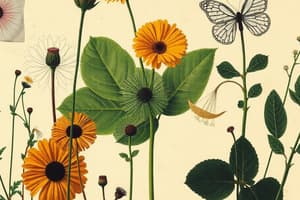Podcast
Questions and Answers
What is the primary function of the roots in a plant?
What is the primary function of the roots in a plant?
- To absorb oxygen from the air
- To anchor the plant and absorb water and nutrients (correct)
- To regulate the plant's temperature
- To absorb sunlight for photosynthesis
What is the process by which a plant cell uses sunlight to make food?
What is the process by which a plant cell uses sunlight to make food?
- Respiration
- Translocation
- Transpiration
- Photosynthesis (correct)
What is the term for the process of a seed growing into a young plant?
What is the term for the process of a seed growing into a young plant?
- Photosynthesis
- Germination (correct)
- Mitosis
- Transpiration
What is the term for the movement of fluids containing sugars produced by photosynthesis?
What is the term for the movement of fluids containing sugars produced by photosynthesis?
What is the primary function of chlorophyll in plants?
What is the primary function of chlorophyll in plants?
What is the term for the process by which water moves through a plant?
What is the term for the process by which water moves through a plant?
What is the term for the process by which plant cells divide?
What is the term for the process by which plant cells divide?
What is the term for the vascular tissue that conducts water and dissolved minerals from the roots to the leaves?
What is the term for the vascular tissue that conducts water and dissolved minerals from the roots to the leaves?
What is the term for the process by which water enters the plant through the roots?
What is the term for the process by which water enters the plant through the roots?
What are the three important nutrients for plant growth?
What are the three important nutrients for plant growth?
Study Notes
Characteristics of Plants
- Plants exhibit varying sizes and shapes, but are all multicellular and composed of tissues and organs.
- Plant cells have cell walls, and all green plant parts contain chlorophyll.
Seeds
- A seed is a structure containing a plant embryo and a supply of food within a protective seed coat.
- Seeds can survive harsh conditions, such as freezing temperatures and drought.
- Germination is the process by which a seed grows into a young plant, but only occurs when environmental conditions are suitable (e.g., temperature, water availability, light, and oxygen availability).
Dormant and Active Life of Plants
- Most plants have a rhythmic seasonal activity, alternating between active and slow life.
- During slow life, plants have increased resistance to unfavorable environmental conditions, appear inactive, stop growing, and reduce respiratory activity and energy use.
- Environmental changes, such as increased temperature and day length, trigger seed germination and bud blossoming.
Parts of the Plant
- A plant consists of three main parts: roots, stems, and leaves.
- Roots anchor the plant, absorb water and nutrients, and transport them to other parts of the plant.
- Stems support the plant body, carrying water and nutrients from roots to other parts.
- Leaves are the organs responsible for making food through photosynthesis, using sunlight.
Requirements for Growing Plants Indoors
- Plants need sufficient space to grow (room to grow).
- Temperature should be maintained between 15°C and 25°C for optimal growth.
- Plants require strong light, with 7 to 12 hours of light per day.
- Watering should be done as needed, as under-watering leads to wilting and over-watering leads to root rot.
- Plants need air, taking it up through their leaves and roots.
- Nutrients, such as nitrogen, phosphorus, and potassium, are essential for plant growth.
Photosynthesis
- Photosynthesis is the process by which plant cells convert sunlight, water, and carbon dioxide into oxygen and food (glucose).
- Chlorophyll, located in chloroplasts, captures solar energy.
- Plants use oxygen for breathing, and food produced by photosynthesis for energy and growth.
- Open stomata allow for carbon dioxide entry and oxygen exit, along with water vapor.
The Vascular System of Plants
- Some plants contain vascular tissues (xylem and phlom) that transport water and nutrients throughout the plant.
- Xylem conducts water and minerals from roots to leaves.
- Phloem conducts sugars and organic nutrients from leaves to the rest of the plant.
Cell Division in Plants
- Plant cell division differs from animal cell division.
- Plant cells divide by mitosis, resulting in genetically identical daughter cells.
- Cytokinesis divides the cytoplasm of the cell into two.
Transportation of Fluids in Plants
- Green plant roots absorb water and nutrients from the soil through osmosis.
- Water moves through vascular tubes by capillary action and transpiration.
- Transpiration is the loss of water through stomata, while translocation is the movement of sugar-containing fluid produced by plants.
Studying That Suits You
Use AI to generate personalized quizzes and flashcards to suit your learning preferences.
Description
This quiz covers the basic characteristics of plants, including their size, shape, cell structure, and seeds. It also explains the process of germination and the importance of seeds in plant reproduction.




